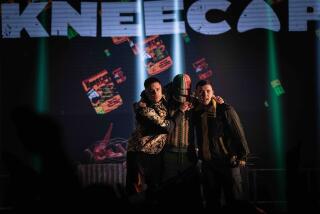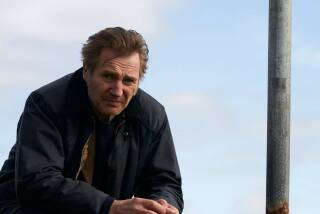VACATION MEMORIES : Oh, to Be in Ireland Now That Winter Is Here
“Just wait until St. Patrick’s Day,” everyone told us during our year’s sabbatical in Ireland. “That’s when the Yanks start coming, and from then until September, nothing will be the same.”
In Ireland, where left can mean right when it comes to directions, we weren’t surprised that America’s great day for the Irish should be considered a great day for Americans. What we didn’t expect was that by March 17--six months into our stay--the visiting Americans, instead of reminding us of home, would seem more like foreigners from a country we’d never seen.
But we had been discarding expectations almost since we arrived. The Ireland of travel advertisements, of smiling green fields and light-hearted people, had vanished in the first cold winds of September, replaced by a weather-battered island in the North Atlantic. The country we hoped to visit was closed until spring.
Whipped by gale-force winds, capped by rain-laden clouds and making do with a bare seven hours of daylight, Ireland in winter offers daily life as a challenge.
We huddled at bus stops in driving rain, our umbrellas inside out, and hurried home to turf fires that took the chill off the central heating. The people we met were a quiet lot, as subdued by the climate as we were. They were helpful and friendly when called on, but with a reserve not too different from their British neighbors.
Indoors, in pubs and homes where sensible people spent as much time as possible, we found the free-flowing talk we expected, good-natured and witty. Yet beneath the apparent frankness lay a formality that was rarely breached--a counterpart to the low walls that enclose every Irish home and property, brick in the city, stone in the country.
We noticed other, invisible, walls. They surrounded men parked in cars along the sea front reading newspapers; mid-winter swimmers changing clothes behind deftly moving towels, confident that passers-by would pay no attention; and a long-haired man perched on a Dublin trash can, reading Machiavelli as fashionable shoppers brushed past. In a country where climate, politics and economics do not make life easy, a buffer of privacy--especially in public--cushions the edges of reality.
Even the children impressed us with their courtesy. Our daughter’s friends pursed their lips and told of “bold” children at school--”boldness” covering a range of self-assertion much of which might go unnoticed in an American school. It was time for us to measure up.
By mid-March we were blending in like a subtly different shade in a well-worn tweed--softening voices, buttoning up manners and never intruding on a new acquaintance by asking that staple of American conversation, “What do you do?” One of our Irish friends complimented us, “I thought all Americans sounded like ‘I Love Lucy’; I never met any like you.”
And then the Americans came, as we had been told they would.
The bank was crowded at lunchtime a few days before St. Patrick’s Day when, over the usual melodious murmur, came a flat nasal voice, startling as the slap of a beaver tail on a rippling brook.
“George,” it called from two lines over, and the ripples dissolved into silence. “Mildred said she’d meet you back at the hotel at one. She went looking for those sweaters.”
“Sssh,” I wanted to whisper, “we don’t do that here.” The murmurs began again and I waited my turn, hoping my American accent would pass unnoticed.
Although spring in Ireland reportedly begins on Feb. 1, St. Patrick’s Day was damp and gray, not too different from any other that winter when it didn’t happen to be raining or blowing up a gale. Except along the parade route, the streets of Dublin were deserted, businesses closed for the holiday, pubs for the holy day.
If St. Patrick had obliged with a summer feast, the Irish might rival the Italians or Spanish in honoring their saint, but on a raw day in the northern latitudes spontaneity took second place to cold feet and chattering teeth. It was determination, not high spirits, we applauded, as bands, youth groups and civic and religious organizations paraded by.
One float made a brave show of rising above the weather: half a dozen young women in white strapless gowns gathered around a “queen” in a glittering tiara, their arms and shoulders the pale purple of swimmers emerging from the Irish Sea in January. We hoped they wouldn’t catch pneumonia.
Then, just at the end of the parade, the American contingents came into sight and the tempo picked up. The Emerald Society Band of the Boston Police Department marched tall and proud, 20th-Century pilgrims with drums and brass, come 3,000 miles to celebrate their Irish roots.
Busloads of tourists followed, smiling and waving from windows or walking alongside to greet the crowd. These Americans were bigger than the Irish we were used to, well-fed and well-preserved.
“American women don’t get old,” I had been hearing for months, and the middle-aged blondes in pastel pantsuits seemed to prove it. They flitted like matronly fairies in a land of sober woolens.
American enthusiasm was too much for a nearby 12-year-old. “These Yanks think they’re so great,” she muttered to a friend.
I knew it wasn’t true, but I couldn’t hope to explain in a few minutes what had taken us months to understand. In understated Dublin, American self-confidence looked suspiciously like boldness, the bane of every Irish child. Whatever their ancestry, these Americans were indeed a foreign breed.
After March 17, American voices were everywhere, asking directions, sharing reactions and preparing us for our return home.
We left Ireland in June during a 75-degree heat wave, while year-round residents peeled off layers of clothing and stretched toe-to-toe in every beach and park, soaking up the sun. It took us longer to shed the protective coloring we had acquired over 10 months, often unknowingly.
In France and Italy, when we passed for English, we found it amusing. But the closer we got to home the less funny it seemed. On our last night in Europe a couple from Chicago let us know how much we had changed.
“There’s no way you’re Americans,” the man said. “Just listen to your little girl; nobody from New Jersey ever talked like that.” We convinced him with our passports, but began to wonder what we had done to ourselves.
Immigrants tell of their joy at first sight of the Statue of Liberty; I think instead of two ordinary moments when--out of the confusion of moving a family of four, their necessities and would-be necessities across the ocean--came the clear, sure realization that we were back where we belonged.
We were in central New Jersey by the time I emerged from the daze of customs, traffic and family reunions. Green suburban lawns rolled past, one into another, not a brick or stone wall in sight. We were in a young country, optimistic and open, with none of the caution bred by centuries of conflict. It felt right.
My confusion returned next morning at the supermarket. The endless display of familiar and unfamiliar products, people I might know and had forgotten--decisions pressed in on me.
The woman behind the deli counter (I was sure she was new since last year) smiled brightly at me. “Hi, hon,” she made room for herself in my crowded consciousness. “How are you today?”
I needed an easier question, but it didn’t matter. I retrieved my American smile from where I had left it in storage and plunged ahead.
“Fine, thanks,” I said. “How about you?”
More to Read
Sign up for The Wild
We’ll help you find the best places to hike, bike and run, as well as the perfect silent spots for meditation and yoga.
You may occasionally receive promotional content from the Los Angeles Times.






